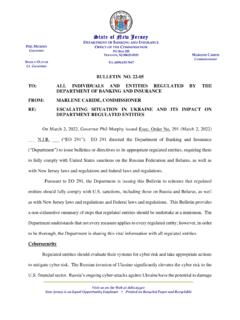Transcription of Analysis of Extended Producer Responsibility Schemes
1 REPORT Analysis of Extended Producer Responsibility Schemes Assessing the performance of selected Schemes in European and EU countries with a focus on WEEE, waste packaging and waste batteries Julian Ahlers, Morton Hemkhaus, Sophia Hibler, J rgen Hannak Imprint Publisher: adelphi consult GmbH Alt-Moabit 91 10559 Berlin +49 (030) 8900068-0 Authors: Julian Ahlers, Morton Hemkhaus, Sophia Hibler, J rgen Hannak Reviewers: Luk van Wassenhove (INSEAD), Jessika Richter (IIEEE Lund) Photo credits: dantetg - Status: June 2021 2021 adelphi Table of Contents I Table of Contents Table of Contents .. I List of Figures ..II List of Tables ..III List of IV Executive Summary .. V 1 Introduction ..1 Motivation for this Study ..1 Methodology.
2 2 Reading Guidance ..4 2 Towards Circularity: Relevant Policy Frameworks and EPR Schemes and in the Relevant Policy Frameworks and Legislation in the Context of EPR ..5 Overview of EPR Schemes in Europe and the EU ..8 3 Closing the Loop or Running in Circles? Performance Assessment of Selected EPR Schemes .. 12 Italy (WEEE) .. 12 Belgium (WEEE) .. 22 Germany (Packaging) .. 34 Spain (Packaging) .. 46 United Kingdom (Batteries) .. 57 Switzerland (Batteries) .. 67 4 Promoting an Effective EPR Landscape in Europe and the EU .. 76 Strengths and Weaknesses of Different Schemes .. 76 Strengthening the Prospect of Competitive EPR Schemes .. 79 5 Conclusion .. 86 Annex .. 88 Annex I. Key Performance Indicators .. 88 Annex II. Interview Guides .. 90 6 Publication bibliography.
3 100 List of Figures II List of Figures Figure 1: KPIs for EPR Schemes analysed in each of the six case studies 3 Figure 2: Policy and regulatory frameworks on waste and EPR in the EU 5 Figure 3: EPR Schemes for WEEE in Europe 9 Figure 4: EPR Schemes for waste packaging in Europe 10 Figure 5: EPR Schemes for waste portable batteries and accumulators in Europe 11 Figure 6: Share of WEEE categories collected in Italy 15 Figure 7: Development of the WEEE collection rate in Italy (2010 - 2019)* 15 Figure 8: WEEE recovery and recycling and re-use targets in Italy 17 Figure 9: Development of recovery and recycling and re-use rate in Italy 17 Figure 10: Average contribution per tonne POM for 5 common reference appliances in Italy 18 Figure 11: Average cost for transport of WEEE from initial point of collection to treatment plant 18 Figure 12: Costs/revenues for the recycling of WEEE in Italy 19 Figure 13: Development of the collection network in Belgium 24 Figure 14: WEEE collection as per category in Belgium 26 Figure 15: Development of WEEE collection in tonnes/year in Belgium 26 Figure 16: Development of WEEE collection rates in Belgium 27 Figure 17: Recycling results and legal objectives per appliance category in Belgium 28 Figure 18: Development of the recycling and recovery rates in Belgium 29 Figure 19: All-in contribution per device charged by Recupel for 5 reference appliances 29 Figure 20: Development of Recupels financial reserves (in million ) between 2001 and 2021 30 Figure 21.
4 Average Recupel contribution (tonne/POM) based on 5 reference appliances 31 Figure 22: PRO maret share in 2020 (based on the ammount of packaging POM by their customers) 36 Figure 23: Development of collection/ recycling rates of household packaging waste in Germany 38 Figure 24: Development of Producer contributions per tonne of packaging waste 42 Figure 25: Number of collection containers for packaging waste in Spain 48 Figure 26: Development of collection/ recycling rates of household packaging waste in Spain 49 Figure 27: Packaging waste disposed in yellow and blue containers in Spain (kg/ capita) 50 Figure 28: Development of recycling rates for packaging waste fractions in Spain 51 Figure 29: Ecoembes revenues 2019 52 Figure 30: Development of contributions per tonne of packaging waste 52 Figure 31: Ecoembes expenses 2019 54 Figure 32: PRO market share (based on batteries POM by their customers) 58 Figure 33: Waste portable batteries collection in the UK 60 Figure 34: Waste portable batteries collected in 2019 by chemistry 61 Figure 35: Rate of collected waste portable batteries by ABTOs/ABEs 63 Figure 36: Average PRO contributions for portable batteries between 2010 and 2020 64 Figure 37: Collection rate for waste batteries in Switzerland 70 Figure 38: Development of battery recycling rates in Swizerland 71 Figure 39: Development of ARF revenues per tonne of batteries POM in Switzerland 71 Figure 40.
5 Average ARF per tonne for 4 reference battery chemistries in Switzerland 72 Figure 41: Cost for collection (total and per tonne of batteries collected) in Switzerland 73 Figure 42: Recycling costs per tonne of waste batteries accepted for recycling in Switzerland 74 Figure 43: Recommendations for the effective implementation of existing and upcoming EPR requirements 87 List of Tables III List of Tables Table 1: Collection and recycling targets for WEEE according to Directive 2012/19/EU 6 Table 2: Collection and recycling targets for packaging waste according to Directive 94/62/EC 7 Table 3: Collection and recycling targets for batteries and accumulators according to Directive 2006/66/EC 7 Table 4: Italy - EPR Performance Indicators 12 Table 5: Good operating thresholds and efficency rewards for WEEE collection points in Italy 19 Table 6: Belgium - EPR Performance Indicators 22 Table 7: Germany - EPR Performance Indicators 34 Table 8: Recovery volumes of packaging in Germany in 2018, based on system participation volumes 38 Table 9: Exported plastic packaging waste (% of total packaging waste) in 2018 and 2019 39 Table 10: Recycling rates and targets in Germany in 2018 and 2019 40 Table 11: Operational costs of the dual systems 2003 and 2011 41 Table 13: Approximation of annual expenditures for waste management services in Germany 42 Table 14: Spain - EPR Performance Indicators 46 Table 15: United Kingdom - EPR key performance indicators at a glance 57 Table 16.
6 Switzerland - EPR key performance indicators at a glance 67 Table 17: Key performance indicators for EPR Schemes 88 Table 18: Interview guide for scoping interviews 90 Table 19: Interview guide for case study evaluation 95 List of Abbreviations IV List of Abbreviations ABE Approved Battery Exporter ABTO Approved Battery Treatment Operator ARF Advance Recycling Fee BAFU Swiss Federal Office for the Environment BW White Goods CEAP Circular Economy Action Plan CF Fridges and Freezers DCF Designated Collection Facilities EC European Commission EEA European Economic Areas EEE Electrical and Electronic Equipment EPR Extended Producer Responsibility EU European Union GS Gemeinsame Stelle dualer Systeme Deutschlands KPI Key performance indicator LMP Light Bulbs LVP Lightweight packaging MoE Ministry of the Environment MSW Municipal Solid Waste OTH Other Devices POM Put on Market PPW Packaging and Packaging Waste PRO
7 Producer Responsibility Organisation RAC Recupel Approved Collectors SUP Single-Use Plastic Directive TVM Televisions and Screens UBA German Environmental Protection Agency (Umweltbundesamt) VAT Value Added Tax WEEE Waste Electrical and Electronic Equipment WFD Waste Framework Directive ZSVR German Central Registry (Zentrale Stelle Verpackungsregister) Executive Summary V Executive Summary First introduced in the 1990s in Germany, Sweden and France, the reputation of Extended Producer Responsibility (EPR) as a powerful tool for promoting effective waste management solutions has grown tremendously and was meanwhile adopted by an increasing number of countries. Due to differences in national legislations, however, the landscape and performance of EPR Schemes remains extremely heterogeneous and vastly differs amongst European countries and EU Member States, with some EPR Schemes consistently performing above average, meeting the increasingly ambitious targets set out at EU level ( in terms of collection rates), and others continuing to underperform.
8 As a result, many stakeholders have expressed their concerns about the increasing complexity of the EPR landscape, highlighting that the large discrepancies between countries can create inefficiencies and adversely affect the functioning of the EU single market. In an effort to streamline and further harmonise the implementation of EPR across the EU, the latest revision of the Waste Framework Directive (WFD), adopted in 2018, laid out general minimum requirements as part of Article 8a (European Parliament and Council 11/22/2008). Defining, among other things, that Member States: (1) introduce specific objectives and/or targets for waste management; (2) put in place specific obligations for Producer Responsibility Organisations (PROs); (3) implement adequate monitoring and enforcement mechanisms to reduce free-riding and appoint at least one body independent of private interests to oversee the implementation for countries with multiple EPR Schemes ; and (4) define a minimum scope of EPR cost coverage and encourage eco-design by implementing eco-modulated fees, whilst ensuring that waste management services are delivered in a cost-effective way.
9 In order to effectively implement these requirements, there is an urgent need to better understand the conditions under which EPR systems can perform well and deliver best results. Based on an in-depth assessment of 6 case studies, supported by results from a literature review, expert interviews and focus group discussions, this study aims to fill this knowledge gap by analysing the performance of different EPR Schemes in Europe and the EU. The Analysis demonstrates that the performance of EPR Schemes for Waste Electrical and Electronic Equipment (WEEE), waste packaging and waste batteries is strongly influenced by the countries socio-economic contexts and national modalities for implementation.
10 Although the difference in scope, distribution of tasks, definitions, methods, data quality, etc. does not allow for a performance comparison of EPR Schemes on a one-to-one basis, the Analysis resulted in a range of overarching observations on the advantages and drawbacks of different Schemes as well as for EPR systems in general. To address identified shortcomings in the light of regulatory requirements for competitive EPR Schemes in Europe and the EU, the study further proposes a range of recommendations for effective implementation of existing and upcoming EPR requirements. These recommendations may serve as inputs for the upcoming EPR guidelines and/or regulatory reforms, supporting the improved and harmonised implementation of EPR across the EU and other European countries.



